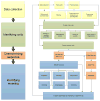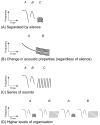Acoustic sequences in non-human animals: a tutorial review and prospectus
- PMID: 25428267
- PMCID: PMC4444413
- DOI: 10.1111/brv.12160
Acoustic sequences in non-human animals: a tutorial review and prospectus
Abstract
Animal acoustic communication often takes the form of complex sequences, made up of multiple distinct acoustic units. Apart from the well-known example of birdsong, other animals such as insects, amphibians, and mammals (including bats, rodents, primates, and cetaceans) also generate complex acoustic sequences. Occasionally, such as with birdsong, the adaptive role of these sequences seems clear (e.g. mate attraction and territorial defence). More often however, researchers have only begun to characterise - let alone understand - the significance and meaning of acoustic sequences. Hypotheses abound, but there is little agreement as to how sequences should be defined and analysed. Our review aims to outline suitable methods for testing these hypotheses, and to describe the major limitations to our current and near-future knowledge on questions of acoustic sequences. This review and prospectus is the result of a collaborative effort between 43 scientists from the fields of animal behaviour, ecology and evolution, signal processing, machine learning, quantitative linguistics, and information theory, who gathered for a 2013 workshop entitled, 'Analysing vocal sequences in animals'. Our goal is to present not just a review of the state of the art, but to propose a methodological framework that summarises what we suggest are the best practices for research in this field, across taxa and across disciplines. We also provide a tutorial-style introduction to some of the most promising algorithmic approaches for analysing sequences. We divide our review into three sections: identifying the distinct units of an acoustic sequence, describing the different ways that information can be contained within a sequence, and analysing the structure of that sequence. Each of these sections is further subdivided to address the key questions and approaches in that area. We propose a uniform, systematic, and comprehensive approach to studying sequences, with the goal of clarifying research terms used in different fields, and facilitating collaboration and comparative studies. Allowing greater interdisciplinary collaboration will facilitate the investigation of many important questions in the evolution of communication and sociality.
Keywords: Markov model; acoustic communication; information; information theory; machine learning; meaning; network analysis; sequence analysis; vocalisation.
© 2014 Cambridge Philosophical Society.
Figures












References
-
- Adam O, Cazau D, Gandilhon N, Fabre B, Laitman JT, Reidenberg JS. New acoustic model for humpback whale sound production. Applied Acoustics. 2013;74:1182–1190.
-
- Adami C. What is complexity? BioEssays. 2002;24:1085–1094. - PubMed
-
- Adams DC, Anthony CD. Using randomization techniques to analyse behavioural data. Animal Behaviour. 1996;51:733–738.
-
- Anderson TW, Goodman LA. Statistical inference about Markov chains. The Annals of Mathematical Statistics. 1957;28:89–110.
Publication types
MeSH terms
Grants and funding
LinkOut - more resources
Full Text Sources
Other Literature Sources

